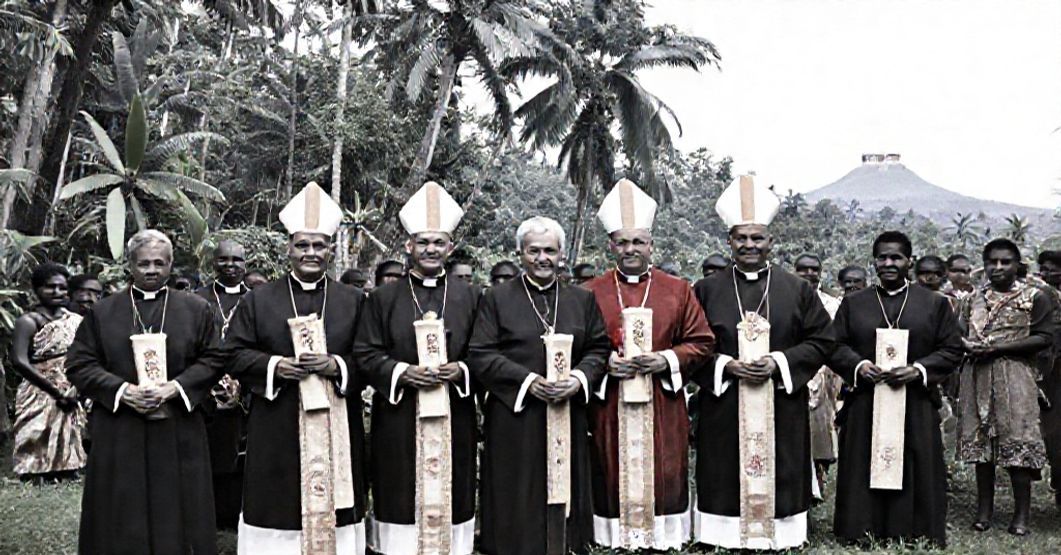Antipopes of the Antichurch



















Timeline of this heretical pontiff
Encyclical Letters
+ 15 posts1959
+ 7 posts1961
+ 4 posts1962
+ 2 posts1963
+ 2 postsApostolic Exhortations
+ 3 postsApostolic Constitutions
+ 93 posts1958
+ 6 posts1959
+ 87 postsMotu Proprio
+ 15 posts1958
+ 1 posts1959
+ 1 posts1962
+ 11 postsApostolic Letters
+ 151 posts1958
+ 4 posts1959
+ 63 posts1960
+ 78 posts1961
+ 1 posts1962
+ 4 posts1963
+ 1 postsSpeeches
+ 99 posts1958
+ 2 posts1959
+ 26 posts1960
+ 29 posts1961
+ 16 posts1962
+ 24 postsMessages
+ 6 posts1959
+ 4 postsHomilies
+ 4 postsLetters
+ 152 posts1958
+ 1 posts1959
+ 48 posts1960
+ 32 posts1961
+ 31 posts1962
+ 30 posts1963
+ 10 postsNot categorized
+ 1 posts1958
+ 1 postsNews feed


Portus Alexii et Vevakensis (1959.06.18)
The document issued under the name of John XXIII on June 18, 1959, entitled “Portus Alexii et Vevakensis,” is a juridical act restructuring mission territories in Papua New Guinea: carving out three new apostolic vicariates (Goroka, Mount Hagen, Lae) from the existing vicariates of Portus Alexii (Alexishafen) and Vevak, and entrusting them respectively to the Society of the Divine Word and the Missionaries of Mariannhill. It wraps a purely administrative partition in solemn formulae of papal authority, invoking the universality of Christ’s redemption and the extension of the Church to all nations as its theological preamble, and concludes with standard canonical clauses concerning execution, authenticity, and penalties.


Portalegrensis in Brasilia (1959.06.20)
The presented document, issued by John XXIII on 20 June 1959 under the title Portalegrensis in Brasilia, is an apostolic constitution that administratively detaches a group of municipalities from the archdiocese of Porto Alegre (Brazil) to erect a new diocese named “Sanctae Crucis in Brasilia” (Santa Cruz do Sul), defines its territory and cathedral, subordinates it as suffragan to Porto Alegre, regulates the initial chapter/consultors, seminary obligations, revenues of the episcopal mensa, and prescribes canonical norms for governance, documents, and execution. It is presented as an act of pastoral solicitude flowing from the alleged Petrine authority of John XXIII and presupposes the entire conciliar-ecclesiological project soon to be launched. In reality, this apparently technical act already manifests the usurper’s claim to jurisdiction, embeds itself in the emerging conciliar sect, and prepares an institutional scaffolding for the post-1958 revolution against the Kingship of Christ and the visible continuity of the true Church.


BUKAVUENSIS (1959.06.30)
The Latin text issued under the name of John XXIII, titled “Bukavuensis (Gomaënsis),” announces the erection of a new apostolic vicariate of Goma in Belgian Congo, by detaching territory from the existing Vicariate Apostolic of Bukavu, assigning jurisdictional boundaries, entrusting it to indigenous clergy, and delegating execution to the then apostolic delegate and competent dicastery. It presents this purely juridical act as an instrument to “better” care for souls and expand the Church’s presence in Central Africa.


Hiroshimaensis (1959.06.30)
The Latin text issued under the name of John XXIII announces the elevation of the Apostolic Vicariate of Hiroshima, entrusted to the Jesuits, to the status of a diocese, suffragan to Nagasaki, with its see in Hiroshima and its cathedral at the church of the Assumption of the Blessed Virgin Mary, establishing a canonical structure with chapter or diocesan consultors, seminary, episcopal mensa, and subjection to the Congregation of Propaganda Fide according to the 1917 Code of Canon Law.
Varia
Announcement:
– News feed –implemented
– Antipopes separate web sites with their all documents refutation – in progress
